|
|
|
Sort Order |
|
|
|
Items / Page
|
|
|
|
|
|
|
| Srl | Item |
| 1 |
ID:
106617
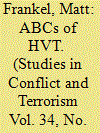

|
|
|
|
|
| Publication |
2011.
|
| Summary/Abstract |
The use of high value targeting (HVT)-using military and police forces to kill or capture leaders of insurgent and terrorist groups-has increased exponentially since the terrorist attacks of September 11, 2001. HVT operations have become the primary tool of the United States for combating Al Qaeda and its affiliates worldwide, and while these operations have eliminated scores of terrorists and insurgents from the battlefield, they haven't always led to strategic success. Utilizing a data set of 20 distinct HVT campaigns dating back to the end of World War II, this article will highlight the positive and negative effects of HVT efforts throughout history and identify six key lessons from past campaigns and their implications for the United States. The body of the paper looks at the important issues inherent to any HVT campaign, including the benefits of having a local force carry out the campaign, the importance of incorporating HVT into a larger counterinsurgency strategy, and the necessity of understanding the dynamics of the group being targeted. The United States has historically struggled in all of these areas, leading to difficulties in achieving success through HVT operations, but these historical lessons also provide opportunities for progress. The article concludes with important implications for the United States and identifies strategies for improvement in these pivotal areas, including expanding relationships with host governments, leveraging new technologies, and contemplating unique ways to approach target sets. Failure to make these changes, the article argues, will leave the United States with the same strategic failures it had with the infamous "deck of cards" in Iraq, where the focus on HVT at the expense of counterinsurgency both helped create and failed to stop the spread of a nationwide insurgency.
|
|
|
|
|
|
|
|
|
|
|
|
|
|
|
|
| 2 |
ID:
091891
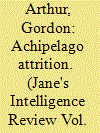

|
|
|
|
|
| Publication |
2009.
|
| Summary/Abstract |
The Islamist insurgent group, the Abu Sayyaf Group, has proven its ability to inflict significant losses on the Philippine military in recent attacks. Gorden Arthur examines the army's operations aimed at dismantling the rebel group and undermining its civilian support.
|
|
|
|
|
|
|
|
|
|
|
|
|
|
|
|
| 3 |
ID:
091306
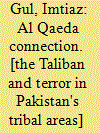

|
|
|
|
|
| Publication |
New Delhi, Penguin Group, 2009.
|
| Description |
viii, 308p.
|
| Standard Number |
978067082926
|
|
|
|
|
|
|
|
|
|
|
|
Copies: C:2/I:0,R:0,Q:0
Circulation
| Accession# | Call# | Current Location | Status | Policy | Location |
| 054396 | 363.325095491/GUL 054396 | Main | On Shelf | General | |
| 054510 | 363.325095491/GUL 054510 | Main | On Shelf | General | |
|
|
|
|
| 4 |
ID:
092483
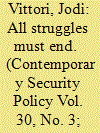

|
|
|
|
|
| Publication |
2009.
|
| Summary/Abstract |
Audrey Kurth Cronin wrote that Terrorism, like war, never ends; however, individual terrorist campaigns and the groups that wage them always do. In order to understand whether counterterrorism strategies and methods are effective in shortening the life-span of individual terrorist groups, scholars and statesmen must first recognize what the survival rate of a terrorist organization is, and what factors contribute to it-a topic that remains understand.
|
|
|
|
|
|
|
|
|
|
|
|
|
|
|
|
| 5 |
ID:
089091
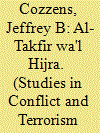

|
|
|
|
|
| Summary/Abstract |
A considerable body of unchallenged literature describes al-Takfir wa'l Hijra and its followers-"takfiris"-as a contemporary and highly dangerous trend within the global jihadi movement. Variously described as a network, movement, or group, its members are portrayed monolithically as ultra-secretive, highly skilled militants who easily blend into Western societies and specialize in "quality" operations against Western targets. This article critically assesses these claims using analytical approaches grounded in social movement theory and Netwar, and data drawn from historical and Islamist sources.
|
|
|
|
|
|
|
|
|
|
|
|
|
|
|
|
| 6 |
ID:
182538
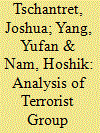

|
|
|
|
|
| Summary/Abstract |
A number of new and exciting datasets on terrorist groups have been created in recent years. However, most data have limited temporal coverage. In this article, we explore a dataset of historical terrorist groups formed between 1860 and 1969 to determine which insights from the terrorism literature are generalizable over time. A cursory look into the dataset reveals several trends that have been overlooked by both the qualitative historical terrorism literature and the quantitative contemporary terrorism literature. We also perform an econometric analysis of terrorist group formation to test hypotheses derived from the extant research. Our results show limited support for existing hypotheses, although civil society participation appears consistently associated with terrorist group formation.
|
|
|
|
|
|
|
|
|
|
|
|
|
|
|
|
| 7 |
ID:
132212
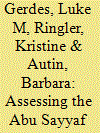

|
|
|
|
|
| Publication |
2014.
|
| Summary/Abstract |
It remains unclear whether the Abu Sayyaf Group (ASG) is a well-structured terror organization that poses a strategic threat, or a loosely organized collection of bandits that poses limited risk. Efforts to assess the nature of the organization are complicated by flaws in existing datasets on Violent Non-State Actors (VNSAs). ASG's role in kidnappings serves as a test-case to estimate incongruities among four major datasets on VNSAs. Original data collected at the agent level provides an additional point of comparison and also serves to test the efficacy of ASG's knowledge-dissemination structures, which are key in determining VNSAs' strategic capacities.
|
|
|
|
|
|
|
|
|
|
|
|
|
|
|
|
| 8 |
ID:
097132
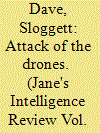

|
|
|
| 9 |
ID:
131111
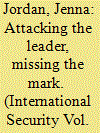

|
|
|
|
|
| Publication |
2014.
|
| Summary/Abstract |
Leadership targeting has become a key feature of counterterrorism policy. Both academics and policymakers have argued that the removal of leaders is an effective strategy in combating terrorism. Leadership decapitation is not always successful, however, and existing empirical work does not account for this variability. A theory of organizational resilience explains why decapitation results in the decline of some terrorist organizations and the survival of others. Organizational resilience is dependent on two variables: bureaucratization and communal support. Older and larger organizations tend to develop bureaucratic features, facilitating a clear succession process and increasing their stability and ability to withstand attacks on their leadership. Communal support plays an important role in providing the resources necessary for terrorist groups to function and survive. Religious and separatist groups typically enjoy a high degree of support from the communities in which they operate, and thus access to critical resources. Application of this theoretical model to the case of al-Qaida reveals that Osama bin Laden's death and the subsequent targeting of other high-level al-Qaida operatives are unlikely to produce significant organizational decline.
|
|
|
|
|
|
|
|
|
|
|
|
|
|
|
|
| 10 |
ID:
090549
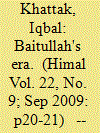

|
|
|
|
|
| Publication |
2009.
|
| Summary/Abstract |
Baitullah Mehsud is now the third top militant leader, after Nek Muhammad and Abdullah Mehsud, to have been pursued and killed since Pakistan joined the US-led 'war on terror'. Yet one mystery will remain regarding Baitullah: Who he was 'working' for? The Afghan government claims the militant groups operating in the border areas are protected by the Pakistani state as 'assets' to use for achieving 'strategic depth' in Afghanistan. But the fact is that it will take years if not decades to deal with the damage that Baitullah caused to the Pakistani psyche and infrastructure.
|
|
|
|
|
|
|
|
|
|
|
|
|
|
|
|
| 11 |
ID:
116224
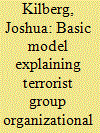

|
|
|
|
|
| Publication |
2012.
|
| Summary/Abstract |
Terrorist groups strive to balance efficiency with their need for security. This article examines the factors that affect a group's choice of organizational structure. I classify 254 groups from the Global Terrorism Database into one of four basic structures: market, all-channel, hub-spoke, or bureaucracy. The results of a multinomial logistic regression reveal that as secret organizations, terrorist groups are not just driven by achieving efficiencies in their organization but rather by protecting against infiltration and threats. Internal factors such as target selection, operational pace, ideology, and stated goals shape a group's structure. External environmental factors such as political rights, civil liberties, polity durability, and state wealth also help shape a group's structure.
|
|
|
|
|
|
|
|
|
|
|
|
|
|
|
|
| 12 |
ID:
112134
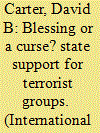

|
|
|
|
|
| Publication |
2012.
|
| Summary/Abstract |
Little existing work has systematically examined the factors that help terrorist groups survive or contribute to their failure. State support for terrorist groups is commonly thought to be a factor that helps groups to survive. I demonstrate with newly collected data that state sponsorship is not always helpful to terrorist groups. The resources provided by sponsors increase a group's ability to maintain itself internally. However, when a group has a sponsor that provides it with safe haven, the risk of the group being forcefully eliminated by the target increases. I argue that sponsors that provide safe haven can have incentives to provide information to the target about the groups to avoid potential costs from target military operations within their territory. The key empirical findings suggest that state sponsorship is a less serious problem for target states than many previously thought.
|
|
|
|
|
|
|
|
|
|
|
|
|
|
|
|
| 13 |
ID:
133678
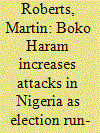

|
|
|
|
|
| Publication |
2014.
|
| Summary/Abstract |
As Nigeria approaches the final six months before a general election in February 2015, there are clear indication that's that the militant Islamist group Boko-Haram is implementing a multi-faceted strategy aimed at increasing the rate of attacks throughout the country.
|
|
|
|
|
|
|
|
|
|
|
|
|
|
|
|
| 14 |
ID:
087306
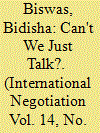

|
|
|
|
|
| Publication |
2009.
|
| Summary/Abstract |
The international community has been increasingly interested in the ways by which external actors help end civil conflicts. This study compares and contrasts the conflicts in Sri Lanka and Indonesia (Aceh) in order to understand why international intervention has failed in Sri Lanka but has been successful in Aceh. In Sri Lanka, the intensely fractured nature of domestic politics has been one of the most significant obstacles to successful peace talks. Although international intervention has become necessary to overcome the trust barriers between the two parties, it is seen as a threat to national sovereignty and therefore rejected. In contrast, the democratization process in Indonesia created new opportunities for peace. The political will of principal actors and their receptivity to external assistance enabled a peace agreement in 2005. The findings of this study show that both domestic political consensus and a supportive international environment, which protect the reputational concerns of the negotiating state, are necessary for resolving protracted ethnonational conflicts.
|
|
|
|
|
|
|
|
|
|
|
|
|
|
|
|
| 15 |
ID:
089740
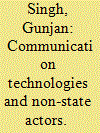

|
|
|
|
|
| Publication |
2009.
|
| Summary/Abstract |
The revolution in communication technology could be said to have happened with the advent of the Internet and Mobile phones. Over the last three to four decades the mobile telephone technology has shown exponential growth. Today, this mode of communication has been used almost in every facet of life. It has significant amount of utility for the armed forces too. Moreover, this technology has become very handy for various non-state actors. In the recent past there are varous incidents where few terrorist groups have used this technology to their advantage. This article attempts to analyze how terrorists groups are cleverly using modern means of communication to their advantage with major emphasis on mobile phones.
|
|
|
|
|
|
|
|
|
|
|
|
|
|
|
|
| 16 |
ID:
130650
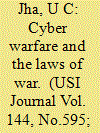

|
|
|
| 17 |
ID:
152885
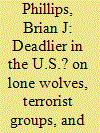

|
|
|
|
|
| Summary/Abstract |
Scholars, politicians, and pundits increasingly suggest lone wolf terrorists are substantial threats, but we know little about how dangerous these actors are—especially relative to other terrorist actors. How deadly are lone actor terrorists? A growing body of empirical research focuses on terrorist organizations, but similar work on lone actors is sparse. Furthermore, attempts to explicitly compare these or other types of terrorist actors are almost non-existent. This article considers theoretical arguments for why lone wolves ought to be especially lethal. However, it presents an argument for why terrorist groups should generally be more lethal. This argument is conditional upon the environment in which actors operate. Lone wolves should only be more deadly in states with especially strong counterterrorism capacity. The article uses data on terrorist attacks in fifteen developed countries, 1970–2010, to compare the lethality of terrorist acts. Around the world, attacks by organizations tend to be far more lethal than attacks by other actors. In the United States, however, lone wolves are generally the more lethal terrorist actors. This is argued to be because the robust counterterrorism capacity makes organized terrorism more difficult to accomplish.
|
|
|
|
|
|
|
|
|
|
|
|
|
|
|
|
| 18 |
ID:
159900
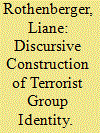

|
|
|
|
|
| Summary/Abstract |
The media coverage of terrorist acts has been the subject of numerous scientific studies. However, the terrorist groups’ own communication perspectives have not been thoroughly researched. The following article deals with terrorist groups and their use of websites for identity building. We examine the discursive construction of terrorist group identity through critical discourse analysis (CDA). The CDA of online texts from websites of terrorist groups is based on a five macro-strategy scheme. Our sample consists of six terrorist groups, with each group of two sharing different motivations: social-revolutionary, ethno-nationalist, or religious. All the groups analyzed are listed as terrorist organizations by the European Union. The CDA of 27 terrorist websites, purposively sampled, was conducted using two coders per site. Through this analysis, the researchers draw conclusions on strategies employed by terrorist organizations in building identity and how to counter their unregulated propaganda.
|
|
|
|
|
|
|
|
|
|
|
|
|
|
|
|
| 19 |
ID:
169932
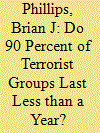

|
|
|
|
|
| Summary/Abstract |
Prominent scholars criticize terrorism research for lacking sufficient empirical testing of arguments. Interestingly, one of the most widely cited estimates in terrorism studies has not been evaluated using the many data sources now available. Rapoport’s 1992 claim, that perhaps 90 percent of terrorist groups last less than one year, has been described as part of the conventional wisdom. This estimate is frequently used to justify studies of terrorist group longevity, a substantial line of research in recent years. Is the estimate accurate? Scholars increasingly publish data sets of terrorist organizations, but no one has analyzed them collectively to see if the 90 percent claim holds up. This article examines the eight largest global data sets of terrorist group longevity, covering 1968–2013. The samples vary considerably, but the percentage of groups that do not survive beyond their first year in these relevant data sets is between 25–74 percent. Across all data sets, on average about 50 percent of terrorist organizations do not make it past their first year. There is some variation depending on group motivations, consistent with Rapoport’s “wave” theory. However, overall, terrorist organizations appear to be more durable than the conventional wisdom suggests.
|
|
|
|
|
|
|
|
|
|
|
|
|
|
|
|
| 20 |
ID:
131472
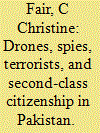

|
|
|
|
|
| Publication |
2014.
|
| Summary/Abstract |
This essay reviews seven recent books and reports that focus upon the use of US armed drones in Pakistan's Federally Administered Tribal Areas (FATA). This essay synthesizes a historical account of the program, critically interrogates key arguments and evidence advanced by the authors, and draws attention the particular problems that confront those who live in the FATA and the second-class citizenship that the Pakistani state has bestowed upon them for reasons of domestic and foreign policy concerns. This review essay does not intend to be the final word on any of the ongoing policy debates. But it does hope to enable a wider audience to take part in these important deliberations.
|
|
|
|
|
|
|
|
|
|
|
|
|
|
|
|
|
|
|
|
|